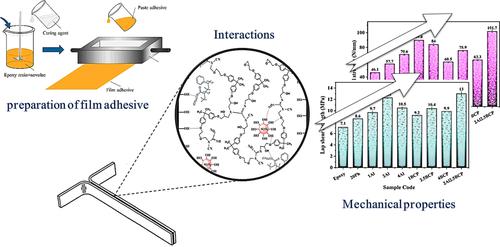当前位置:
X-MOL 学术
›
Polym. Compos.
›
论文详情
Our official English website, www.x-mol.net, welcomes your feedback! (Note: you will need to create a separate account there.)
A new platform for designing high‐performance epoxy film adhesive with poly (butyl acrylate‐block‐styrene) block copolymer and alumina nano particles in aluminum–aluminum bonded joints: Preparation and analysis of the mechanical, adhesion, and thermal properties
Polymer Composites ( IF 5.2 ) Pub Date : 2024-03-13 , DOI: 10.1002/pc.28297 Hamid Ghaderi 1 , Abolfazl Semnani 1 , Omid Moini Jazani 2
A new platform was developed for designing epoxy films adhesives with high mechanical, adhesion, and thermal properties. The hybrid of butyl acrylate block styrene copolymer, phenolic resin, and alumina nanoparticles showed synergistic effects on the lap shear and T‐peel strength. The greatest improvement in toughness was related to the epoxy adhesive containing 2.5 phr block copolymer and 2 phr alumina nanoparticles. Analysis of the fracture surface showed that by using hybrid of nanoparticles and block copolymers in the epoxy film adhesive formulation, the cohesive failure occurred. The use of hybrid additives in film adhesive formulations enlightened manufacture of adhesives for future studies on adhesive formulations.
中文翻译:

用于设计铝-铝粘合接头中聚(丙烯酸丁酯-嵌段-苯乙烯)嵌段共聚物和氧化铝纳米粒子的高性能环氧薄膜粘合剂的新平台:机械、粘合和热性能的制备和分析
环氧薄膜粘合剂通常用于不同的行业。然而,这些粘合剂存在脆性、柔韧性低和热稳定性问题。在这项研究中,酚醛树脂(酚醛清漆)和聚(丙烯酸丁酯-嵌段-苯乙烯)被用于环氧薄膜粘合剂(二缩水甘油醚双酚A)的配方中,以提高热稳定性和粘合强度,并分别用作增韧剂。氧化铝纳米粒子也被用来增强机械性能。还评估了嵌段共聚物和氧化铝纳米颗粒对环氧基薄膜粘合剂的机械和热性能的影响。通过拉伸、搭接剪切和 T 剥离试验评估了哑铃形样品的机械性能和 Al-Al 粘合接头的粘合强度。通过热重分析(TGA)评估最佳样品的热稳定性。SEM 分析也用于研究增韧机制。哑铃形样品的拉伸测试表明,2.5 份嵌段共聚物和 2 份氧化铝纳米颗粒的掺入将韧性提高至 250%。该样品的剪切强度和剥离强度也分别增加了51%和76%,显示出显着的协同效应。另一方面,TGA结果表明嵌段共聚物的加入提高了粘合剂基质的热稳定性。这两种材料的共存对热稳定性也表现出相当大的协同效应。SEM 结果也与力学测试的结果一致,因为裂纹偏差、裂纹钉扎和脱粘是最重要的增韧机制。 开发了一个新平台,用于设计具有高机械、粘合和热性能的环氧薄膜粘合剂。 丙烯酸丁酯嵌段苯乙烯共聚物、酚醛树脂和氧化铝纳米粒子的杂化对搭接剪切和T剥离强度表现出协同效应。 韧性的最大改善与含有 2.5 份嵌段共聚物和 2 份氧化铝纳米颗粒的环氧粘合剂有关。 断裂表面分析表明,在环氧薄膜粘合剂配方中使用纳米颗粒和嵌段共聚物的混合物,会发生内聚破坏。 混合添加剂在薄膜粘合剂配方中的使用启发了粘合剂的制造,为未来粘合剂配方的研究提供了启发。
更新日期:2024-03-13
Polymer Composites ( IF 5.2 ) Pub Date : 2024-03-13 , DOI: 10.1002/pc.28297 Hamid Ghaderi 1 , Abolfazl Semnani 1 , Omid Moini Jazani 2
Affiliation

|
中文翻译:

用于设计铝-铝粘合接头中聚(丙烯酸丁酯-嵌段-苯乙烯)嵌段共聚物和氧化铝纳米粒子的高性能环氧薄膜粘合剂的新平台:机械、粘合和热性能的制备和分析



























 京公网安备 11010802027423号
京公网安备 11010802027423号